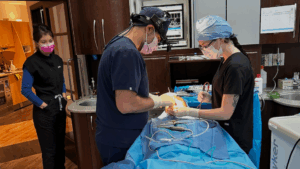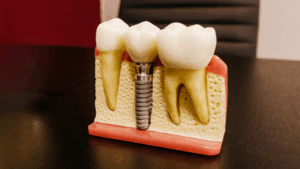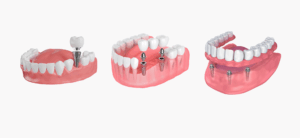Wisdom tooth pain is a common issue among teens and young adults. While some people experience no symptoms, others deal with persistent pain, swollen cheeks, or infections. So how can you tell the difference between a normal eruption and a serious complication? Here are answers to your questions about wisdom teeth, symptoms to watch for, and treatment options.

Why Do Wisdom Teeth Often Cause Pain?
Wisdom teeth, also known as third molars, typically erupt between the ages of 17 and 25. They emerge at the back of the mouth, both upper and lower, often in areas with limited space.
This lack of room frequently causes wisdom tooth pain. These molars may grow crooked or remain partially covered by gum tissue. This can lead to pressure, inflammation, or infection. A narrow jaw increases the risk of complications.
Normal vs. Abnormal Pain: How to Tell the Difference
Some discomfort from erupting wisdom teeth is considered normal, especially when they first begin to emerge. However, it’s important to distinguish between minor irritation and more serious symptoms.
Normal Pain:
- Mild sensitivity at the back of the mouth
- Discomfort when chewing
- Temporary gum inflammation
Abnormal Pain:
- Intense, persistent, or worsening pain
- Swelling of the cheek, redness, or trouble opening the mouth
- Fever, bad breath, or a foul taste in the mouth
According to the Canadian Dental Association, these symptoms may point to an infection, cavity, abscess, or damage to nearby tissues.
Symptoms of an Infected Wisdom Tooth
An infected wisdom tooth is often the result of pericoronitis — inflammation around a partially erupted tooth. Gum tissue that still covers part of the tooth can trap food and bacteria, making the area hard to clean.
Common symptoms include:
- Redness and swelling near the tooth
- Pus or discharge
- Pain spreading to the jaw or head
- Difficulty opening the mouth (trismus)
If left untreated, the infection can spread to the neck and facial tissues, potentially causing cellulitis. In some cases, it may lead to more serious conditions such as systemic infections or periodontal disease. A prompt evaluation is recommended in this case.
Are Headaches Related to Wisdom Teeth?
The eruption of wisdom teeth can sometimes trigger headaches — a symptom that surprises many patients. The pain is often linked to the position of the teeth near jaw nerves and tissues.
If the erupting tooth puts pressure on nearby teeth or tissues, it may create tension that radiates to the head. In addition, jaw muscle contractions — often involuntary during a painful eruption — can intensify these headaches.
If you experience headaches along with wisdom tooth pain, it’s best to speak with your dentist. They can help identify the source of the pain and offer appropriate treatment to relieve discomfort and prevent further issues.
When Is Wisdom Tooth Extraction Recommended?
Wisdom tooth extraction — a common dental procedure — is usually recommended in these situations:
- Impacted or partially impacted tooth causing pain or infection
- Risk of shifting nearby teeth
- Cavities that are hard to treat due to the tooth’s position
Preventive extraction may also be suggested to avoid recurring infections or orthodontic problems. An evaluation by a professional will determine if extraction is the best option.
What to Expect After Extraction: Pain, Swelling & Healing
How long does the pain last?
Post-operative pain typically peaks 1 to 3 days after surgery and gradually subsides within the first week. Pain may last 10 to 14 days, but is usually manageable with proper medication.
Cheek swelling
Swelling after extraction is normal. Swelling usually peaks between 48 and 72 hours post-surgery and then decreases.
Healing phases
A blood clot forms in the wisdom tooth socket to aid healing. If this clot dislodges, a dry socket can occur, causing severe pain. Complete healing (gum and bone) may take 4 to 6 weeks.
How to Relieve Wisdom Tooth Pain at Home
The Canadian Dental Association recommends the following ways to relieve wisdom tooth pain:
- Cold compresses: apply to the cheek for 15 minutes at a time.
- Warm salt water rinses: cleanse the area and promote healing.
- Over-the-counter pain relievers: such as ibuprofen or acetaminophen, as appropriate.
They may offer temporary relief but are not a substitute for professional consultation.
Avoid after extraction:
- Touching the area with your fingers or tongue
- Hard, crunchy, or hot foods
- Smoking, which can slow healing
If symptoms persist for more than three days or worsen, consult your surgeon.
When Should You See a Professional Immediately?
Consult a clinic immediately if you experience any of the following symptoms:
- Fever over 38°C
- Rapid or extensive swelling of the face or neck
- Pain that does not improve with medication
- Difficulty swallowing or breathing
- Pain lasting a month after extraction
These may be signs of serious complications that require immediate care. A proper diagnosis allows for safe and effective treatment.
How to Choose a Trustworthy Clinic
Selecting a reliable clinic is key to ensuring quality care. Choose a clinic known for its professionalism and experienced staff.
Check the clinic’s reviews, ask for recommendations, and make sure it meets current health and safety standards. A modern facility, clear communication, and a friendly, attentive team can help build trust and put you at ease.
By choosing a reliable clinic, you can be sure that you will receive care tailored to your needs and benefit from personalised support throughout your oral health journey.

Conclusion
Wisdom teeth can cause mild discomfort — but they may also lead to more serious issues like infections. Persistent or worsening pain should never be ignored.
Monitoring symptoms, good oral hygiene and regular check-ups at the dentist are essential to avoid problems. If in doubt, a quick consultation is the best solution to preserve your oral health.
Wisdom tooth pain is a common issue among teens and young adults. While some people experience no symptoms, others deal with persistent pain, swollen cheeks, or infections. So how can you tell the difference between a normal eruption and a serious complication? Here are answers to your questions about wisdom teeth, symptoms to watch for, and treatment options.

Why Do Wisdom Teeth Often Cause Pain?
Wisdom teeth, also known as third molars, typically erupt between the ages of 17 and 25. They emerge at the back of the mouth, both upper and lower, often in areas with limited space.
This lack of room frequently causes wisdom tooth pain. These molars may grow crooked or remain partially covered by gum tissue. This can lead to pressure, inflammation, or infection. A narrow jaw increases the risk of complications.
Normal vs. Abnormal Pain: How to Tell the Difference
Some discomfort from erupting wisdom teeth is considered normal, especially when they first begin to emerge. However, it’s important to distinguish between minor irritation and more serious symptoms.
Normal Pain:
- Mild sensitivity at the back of the mouth
- Discomfort when chewing
- Temporary gum inflammation
Abnormal Pain:
- Intense, persistent, or worsening pain
- Swelling of the cheek, redness, or trouble opening the mouth
- Fever, bad breath, or a foul taste in the mouth
According to the Canadian Dental Association, these symptoms may point to an infection, cavity, abscess, or damage to nearby tissues.
Symptoms of an Infected Wisdom Tooth
An infected wisdom tooth is often the result of pericoronitis — inflammation around a partially erupted tooth. Gum tissue that still covers part of the tooth can trap food and bacteria, making the area hard to clean.
Common symptoms include:
- Redness and swelling near the tooth
- Pus or discharge
- Pain spreading to the jaw or head
- Difficulty opening the mouth (trismus)
If left untreated, the infection can spread to the neck and facial tissues, potentially causing cellulitis. In some cases, it may lead to more serious conditions such as systemic infections or periodontal disease. A prompt evaluation is recommended in this case.
Are Headaches Related to Wisdom Teeth?
The eruption of wisdom teeth can sometimes trigger headaches — a symptom that surprises many patients. The pain is often linked to the position of the teeth near jaw nerves and tissues.
If the erupting tooth puts pressure on nearby teeth or tissues, it may create tension that radiates to the head. In addition, jaw muscle contractions — often involuntary during a painful eruption — can intensify these headaches.
If you experience headaches along with wisdom tooth pain, it’s best to speak with your dentist. They can help identify the source of the pain and offer appropriate treatment to relieve discomfort and prevent further issues.
When Is Wisdom Tooth Extraction Recommended?
Wisdom tooth extraction — a common dental procedure — is usually recommended in these situations:
- Impacted or partially impacted tooth causing pain or infection
- Risk of shifting nearby teeth
- Cavities that are hard to treat due to the tooth’s position
Preventive extraction may also be suggested to avoid recurring infections or orthodontic problems. An evaluation by a professional will determine if extraction is the best option.
What to Expect After Extraction: Pain, Swelling & Healing
How long does the pain last?
Post-operative pain typically peaks 1 to 3 days after surgery and gradually subsides within the first week. Pain may last 10 to 14 days, but is usually manageable with proper medication.
Cheek swelling
Swelling after extraction is normal. Swelling usually peaks between 48 and 72 hours post-surgery and then decreases.
Healing phases
A blood clot forms in the wisdom tooth socket to aid healing. If this clot dislodges, a dry socket can occur, causing severe pain. Complete healing (gum and bone) may take 4 to 6 weeks.
How to Relieve Wisdom Tooth Pain at Home
The Canadian Dental Association recommends the following ways to relieve wisdom tooth pain:
- Cold compresses: apply to the cheek for 15 minutes at a time.
- Warm salt water rinses: cleanse the area and promote healing.
- Over-the-counter pain relievers: such as ibuprofen or acetaminophen, as appropriate.
They may offer temporary relief but are not a substitute for professional consultation.
Avoid after extraction:
- Touching the area with your fingers or tongue
- Hard, crunchy, or hot foods
- Smoking, which can slow healing
If symptoms persist for more than three days or worsen, consult your surgeon.
When Should You See a Professional Immediately?
Consult a clinic immediately if you experience any of the following symptoms:
- Fever over 38°C
- Rapid or extensive swelling of the face or neck
- Pain that does not improve with medication
- Difficulty swallowing or breathing
- Pain lasting a month after extraction
These may be signs of serious complications that require immediate care. A proper diagnosis allows for safe and effective treatment.
How to Choose a Trustworthy Clinic
Selecting a reliable clinic is key to ensuring quality care. Choose a clinic known for its professionalism and experienced staff.
Check the clinic’s reviews, ask for recommendations, and make sure it meets current health and safety standards. A modern facility, clear communication, and a friendly, attentive team can help build trust and put you at ease.
By choosing a reliable clinic, you can be sure that you will receive care tailored to your needs and benefit from personalised support throughout your oral health journey.

Conclusion
Wisdom teeth can cause mild discomfort — but they may also lead to more serious issues like infections. Persistent or worsening pain should never be ignored.
Monitoring symptoms, good oral hygiene and regular check-ups at the dentist are essential to avoid problems. If in doubt, a quick consultation is the best solution to preserve your oral health.










